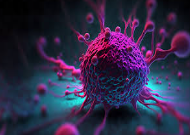Cytotoxicity Assay of Andrographolide Isolated from Sambiloto Herb [Andrographis paniculata (burm.f.)] against Lung Cancer A-549 and Prostate Cancer DU-145 Cell Lines
Main Article Content
Abstract
Lung and prostate cancer have high prevalence rates worldwide, including in Indonesia. Therefore, exploring alternative drug therapies, particularly those from natural sources in the form of extracts or isolates with relatively low side effects, is necessary. One natural substance exhibiting cytotoxic activity is sambiloto [Andrographis paniculata (Burm.F.)]. This plant contains the bioactive compound andrographolide, known for its cytotoxic activity. This study was performed to examine the cytotoxicity of andrographolide isolates against the A-549 lung cancer cell line and the DU-145 prostate cancer cell line. The cytotoxicity test was conducted in vitro using the resazurin reduction method using PrestoBlueTM reagent. Eight concentration series with a 1:2 ratio were employed, ranging from 1,000 ppm to 7.81 ppm, with doxorubicin HCl and cisplatin as the positive control for A-549 and DU-145, respectively. The cytotoxicity parameter IC50 was measured using GraphPad Prism version 8 software. The study results showed moderate cytotoxicity properties of andrographolide isolates with IC50 values of 47.28 μg/mL for A-549 and 49.35 μg/mL for DU-145 cancer cell lines, respectively. Despite showing weaker values than the ones in positive controls, the moderate cytotoxicity could be further explored in cancer research. Further investigations are warranted to fully ascertain the therapeutic potential of andrographolide, which makes it a compelling candidate for future anticancer studies.
Downloads
Article Details

This work is licensed under a Creative Commons Attribution-NonCommercial-NoDerivatives 4.0 International License.
References
Ferlay J, Colombet M, Soerjomataram I, Parkin DM, Piñeros M, Znaor A, Bray F. Global cancer observatory: Cancer Today. [Online]. 2020 [cited 2023 Apr 01]. Available from: https://gco.iarc.fr/today/en.
World Health Organization. Estimated number of new cases in 2020, World, both sexes, all ages. [Online]. 2020 [cited 2023 Apr 01]. Available from: https://gco.iarc.fr/today/online-analysis-table.
Ranjan, A, Ramachandran S, Gupta N, Kaushik I, Wright S, Srivastava S, Das H, Srivastava S, Prasad S, Srivastava SK. Role of phytochemicals in cancer prevention. Int. J. Mol. Sci. 2019; 20(20): 4981. https://doi.org/10.3390/ijms20204981.
Mohs, Richard C, Nigel H, Greig. Drug discovery and development: Role of basic biological research. Alzheimer’s Dementia: TRCI, 2017; 3: 651-657.
Mishra SK, Tripathi S, Shukla A, Oh SH, Kim HM. Andrographolide and analogues in cancer prevention. Front Biosci. 2015; 7: 292–304. https://doi.org/10.2741/E732.
Winingsih W, Firmansyah A, Ayesha R, Novwanti PA, Bahy LN. Synthesis, Characterization, and Application of Molecularly Imprinted Polymer - Modified Silica Gel for Andrographolide Purification from Andrographis paniculata (Burm.f.) Nees Methanol Extract: http://www.doi.org/10.26538/tjnpr/v7i8.28. TJNPR [Internet]. 2023 Aug. 31 [cited 2024 Apr. 24];7(8):3761-5.
Dai Y, Chen SR, Chai L, Zhao J, Wang Y, Wang Y. Overview of Pharmacological Activities of Andrographis paniculata and its Major Compound Andrographolide. Critical Reviews in Food Science and Nutrition. 2019; (59): 17–29. https://doi:10.1080/10408398.2018.1501657.
Banerjee M, Ahmed H, Yang P, Czinn SJ, Blanchard TG. Endoplasmic reticulum stress and IRE-1 signaling cause apoptosis in colon cancer cells in response to andrographolide treatment. Oncotarget. 2016; 7(27), 41432-41444. https://doi.org/10.18632/oncotarget.9180.
Rajagopalan H, Bardelli A, Lengauer C, Kinzler KW, Vogelstein B, Velculescu VE. Tumorigenesis: RAF/RAS oncogenes and mismatch repair status. Nature. 2002; Vol. 12, 418 (6901): 934. https://doi.org/10.1038/418934a.
Lee YC, Lin HH, Hsu CH, Wang CJ, Chiang TA, Chen JH. Inhibitory effects of andrographolide on migration and invasion in human non-small cell lung cancer A549 cells via down-regulation of PI3K /Akt signaling pathway. European Journal of Pharmacology. 2010; 632, 23-32. https://doi.org/10.1016/j.ejphar.2010.01.009.
Mir H, Kapur N, Singh R, Sonpavde G, Lillard JW Jr, Singh S. Andrographolide inhibits prostate cancer by targeting cell cycle regulators, CXCR3 and CXCR7 chemokine receptors. Cell Cycle. 2016; 15(6): 819-826. https://doi.org/10.1080/ 15384101.2016.1148836.
Çelik, T. Cytotoxicity. London, UK: IntechOpen; 2018. 1-5 p.
Ganassin RC, Schirmer K, Bols NC. Cell and tissue culture. San Diego, USA: Academic Press; 2000. 631-651 p. https://doi.org/ 10.1016/B978-012529650-2/50047-0.
Boncler M, Różalski M, Krajewska U, Podsędek A, Watala C. Comparison of prestoblue and MTT assays of cellular viability in the assessment of anti-proliferative effects of plant extracts on human endothelial. J. of Phar. and Toxic. Methods. 2014; 69, 9-16. https://doi.org/10.1016/j.vascn. 2013.09.003.
Aslantürk Ö. S. In vitro cytotoxicity and cell viability assays: principles, advantages, and disadvantages. London, UK: Genotoxicity - A Predictable Risk to Our Actual World; 2018. 1–18 p.
Freshney, Ian. Culture of animal cells: a manual of basic technique and specialized applications. (6th ed.). USA: Wiley-Blackwell Publication; 2010. 1-659 p. https://DOI:10.1002/9780470649367.
Damasuri AR, Sholikhah EN, Mustofa. Cytotoxicity of ((E)-1-(4-aminophenyl)-3-phenylprop-2-en-1-one)) on Hela cell line. Indo. J. of Phar. and Ther. 2020;(2). 54-59 p. https://doi.org/10.22146/ijpther.606.
Thermo Fisher Scientific Inc. Gibco - cell culture basic handbook. Massachusetts, USA: Thermo Fisher Scientific Inc.; 2020. 1-132 p.
Abcam plc. Counting cells using a hemocytometer. Cambridge, UK: Abcam Protocol; 2023. 1-3 p.
Wei Z, Wang R, Yin X, Zhang L, Lei Y, Zhang Y, Li Y, Wu J, Bu Y, Jin G, Zhang C. PRR11 induces filopodia formation and promotes cell motility by recruiting the ARP2/3 complex in non-small cell lung cancer cells. Genes & Diseases. 2021; 9: 230-244. https://doi.org/ 10.1016/j.gendis.2021.02.012.
Barde, Mohini P. & Prajakt J. Barde. What to use to express the variability of data: standard deviation or standard error of the mean. Perspectives in Clinical Research. 2012; 3, (3), 113-116. https://doi: 10.4103/2229-3485.100662.
Katja D, Farabi K, Nurlelasari N, Harneti D, Mayanti T, Supratman U. Awang K, Hayashi H. Cytotoxic constituents from the bark of Chisocheton cumingianus (Meliaceae). J. of Asian Nat. Pro. Res. 2016;19(2):194-200. https://doi.org/10.1080/10286020.2016.1196671.
Hidayat AT, Farabi K, Harneti D, Nurlelasari N, Maharani R, Mayanti T. Supratman U, Shiono Y. A cytotoxic rocaglate compound from the stembark of Aglaia argentea (Meliaceae). Molekul 2017;12(2):146. https://doi.org/10.20884/1.jm.2017.12.2.361.


